
© Valentin Baranovsky. (Click image for larger version)
Mariinsky Ballet
Raymonda
Costa Mesa, Segerstrom Hall
24 September 2015
www.mariinsky.ru
www.scfta.org
West Coast ballet-goers rejoiced when the Mariinsky Ballet and Orchestra announced its California tour, a three-weekend jaunt that opened 24 September at Segerstrom Hall in Costa Mesa. The anticipation was heightened by news that the tour would start with a full-length production of Raymonda – an extremely rare treat. While Russian audiences in both Moscow and St. Petersburg are intimately familiar with Petipa’s final ballet, Americans rarely see more than the third act, or even just its grand pas classique hongrois, which is a gala and mixed-bill staple.
The opportunity to see the complete Raymonda felt especially indulgent on the Pacific Coast because contemporary dance and neoclassical ballet get significantly higher billing here than the classics do. In addition, major international ballet companies visit less often than elsewhere because of the prohibitive distances. Indeed, I flew nearly 400 miles just to see opening night, and another patron told me he trekked to Costa Mesa from rural Colorado. We’re parched out here, and the Great Western Drought applies as much to classical ballet as to our water supply.

© Valentin Baranovsky. (Click image for larger version)
The Mariinsky knows how to do Raymonda, and well they should – Petipa created it on the company in 1898, casting Pierina Legnani in the title role and Sergei Legat, Olga Preobrajenka and Pavel Gerdt in supporting ones. Under the choreographer’s direction, St. Petersburg native Alexander Glazunov composed the music, a polyglot of elegant, Tchaikovskian waltzes, brisk mazurkas and a panoply of Middle Eastern, Hungarian and Spanish dances.
With its thin plot, Raymonda inspires no romantic yearning, tragic tears or even suspense. In 13th-century Hungary, the young countess Raymonda prepares for her name-day party and dreams about the return of her fiancé, Jean de Brienne, from the Fourth Crusade. In a not-so-subtle metaphorical twist, menacing Saracen knight Abderakhman drops in for a beverage, falls in love with Raymonda on sight, and tries to kidnap her. Jean returns in the nick of time, swords are drawn and the restoration of order is celebrated with a wedding. (Whether the subtext is foreign vs. familiar, eroticism vs. restraint, or Muslim vs. Christian is a matter of worthwhile debate.)

© Valentin Baranovsky. (Click image for larger version)
What Raymonda lacks in depth it makes up in dancing, particularly for the ballerina. A definitive test of skill, the title role requires her near-constant presence onstage for extensive adagios with left-right repetitions, multiple pas de deux and numerous allegro and petit allegro variations. But a ballerina is more than a technique machine, and exquisite musicality along with sparkling charisma are required to enliven the choreography that can otherwise seem academic. Choreographers have improved the libretto and added men’s variations over the years; the Mariinsky version, dating from 1948, includes revisions by Konstantin Sergeyev and fragments by Fyodor Lopukhov.
The audience’s fevered mood cooled a bit on opening night, when Viktoria Tereshkina delivered a technically clear but joyless first act. Tension gripped her face during the adagio, making her besotted teenage character seem distant, distracted and fraught with worries beyond her years. Even Vladimir Shklyarov’s insouciant Jean de Brienne could not lift the gloom during his dream-scene visitation, and Tereshkina’s strained postures made their pas de deux seem more mechanical than lyrical.

© Natasha Razina. (Click image for larger version)
Only Tereshkina’s rendition of the pizzicato variation, with daintily plucked chevals, hops and pas de chats accompanied by Elena Klass on harp, foreshadowed a livelier mood to come. Allegro seems more this ballerina’s speed, and in her sparkling sapphire tutu she flew through Act II’s virtuosic variations: a precise diagonal of développés into enveloppés into single pirouettes, and another of perfectly-spaced changements hopped en pointe.
Sweeping in with passionate intent, a satin cape and a retinue of slaves, first soloist Konstantin Zverev’s Abderakhman injected welcome theatrics into the performance. He alone brought sizzle to the stage – even Raymonda swooned, for all her protestations – and sparks literally flew when he and Jean clashed over longswords.

© Valentin Baranovsky. (Click image for larger version)
Tereshkina shone brightest in Act III’s grand pas classique hongrois. Freed from plot considerations, she danced more freely in the piano variation. Seductive, mesmerizing and haughty, she arched over her bourrées with elegant épaulement punctuated by soft claps, and stepped into arabesque balances with a saucy flick of the aigrette. Though not as masterfully controlled as one may have expected, Shklyarov mirrored the exuberance of the trumpet that accompanied his variation, landing double sauts de basque and beaten cabrioles with a smile. The crowd trilled, and everyone lived happily ever after. The audience got a special thrill the following night, when first soloist Oxana Skorik was promoted to principal after her performance in the lead role.
Oxana Skorik was promoted to #Mariinsky principal last night right on our stage! Congratulations! #ballet @Ardani pic.twitter.com/SQY0yeHWNw
— Segerstrom Center (@SegerstromArts) September 26, 2015
First soloist Kristina Shapran gave a glimpse of what might have been; as Raymonda’s friend Clémence, she beautifully modulated the variation’s technical steps into a tender waltz. Coryphée Ekaterina Ivannikova gave a firecracker second dream variation, echoing the mirthful oboe music in zippy entrechats, assembles and chaines, while Anastasia Petushkova showed the same heat in the Spanish dance. The corps de ballet and local students dispatched Raymonda’s many ensemble dances with vivacity.
Simon Virsaladze’s sets and costumes date to this Raymonda’s premiere, setting an understated medieval scene in muted colors and a tasteful application of sparkle. Though they complete the look, the men’s pageboy wigs elicited some stifled giggles. American-born conductor Gavriel Heine, who studied in St. Petersburg, led the orchestra’s lively performance.
The Mariinsky tour continues to Berkeley and Los Angeles, where the company will perform Alexei Ratmansky’s Cinderella.







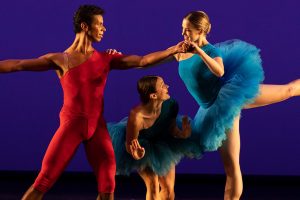
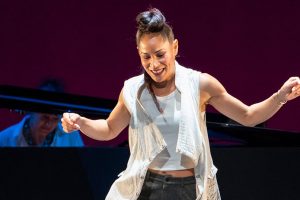
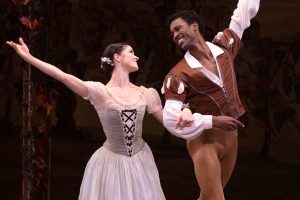

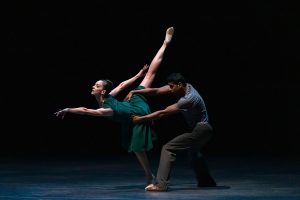
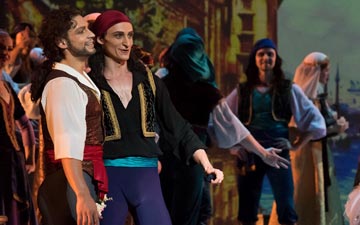


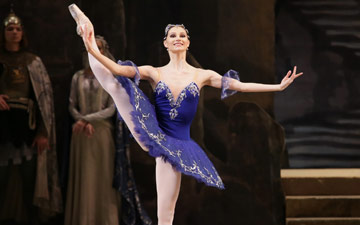
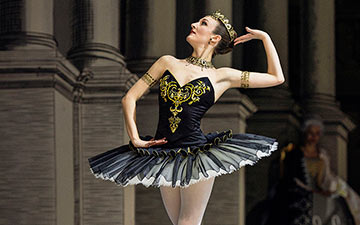
Can you comment on the very long segment of music where the audience stares at nothing but a scrim with sunset clouds going by? It seemed an unusually long time to me for there to be no choreography. I began to wonder if we were going to experience Raymonda’s nap in real time.